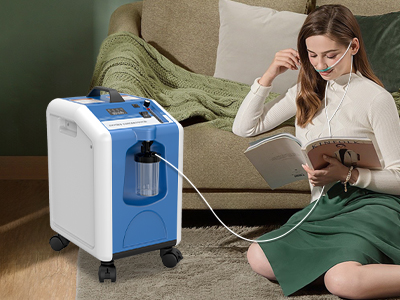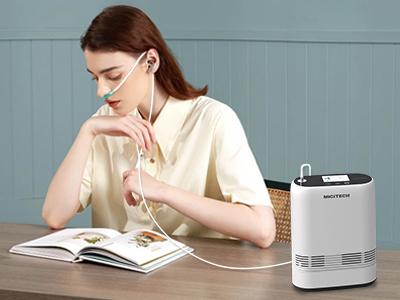23 Feb 2024
Authenticity is paramount when it comes to medical equipment, especially oxygen concentrator, which play a critical role in delivering supplemental oxygen to individuals with respiratory conditions. The use of counterfeit oxygen concentrators can pose serious risks to patients' health and safety, underscoring the importance of recognizing and avoiding counterfeit products.
Counterfeit oxygen concentrators, like many other medical devices, have become increasingly prevalent in the market. These counterfeit products are often designed to mimic genuine models but lack the quality, reliability, and safety standards of authentic devices. As such, it is essential for consumers to be able to identify counterfeit oxygen concentrators to protect themselves and ensure effective treatment.

Understanding Genuine Oxygen Concentrators
A. Components and Features
Genuine oxygen concentrators are equipped with specific components and features that are designed to deliver oxygen safely and effectively. These may include oxygen sensors, compressors, filters, and control panels with various settings for adjusting oxygen flow rates and concentration levels.
B. Quality Standards and Certifications
Authentic oxygen concentrators adhere to strict quality standards and are often certified by regulatory agencies such as the FDA (Food and Drug Administration) or CE (Conformité Européenne) in Europe. These certifications indicate that the device has undergone rigorous testing and meets the necessary safety and performance requirements.
Common Signs of Counterfeit Oxygen Concentrators
A. Discrepancies in Branding and Packaging
One of the telltale signs of a counterfeit oxygen concentrator is inconsistencies in branding, packaging, and labeling. Counterfeit products may have misspelled brand names, poorly printed labels, or packaging that differs from the genuine product.
B. Poor Build Quality and Workmanship
Counterfeit oxygen concentrators often exhibit inferior build quality and workmanship compared to genuine devices. These may include loose fittings, flimsy materials, and overall poor construction that compromises the device's durability and reliability.
Functional Testing and Performance
A. Inaccurate Oxygen Concentration
Testing the oxygen concentration output of a suspected counterfeit oxygen concentrator is essential for verifying its authenticity. An inaccurate oxygen concentration may indicate that the device is counterfeit or of inferior quality, posing potential risks to the user's health.
B. Unreliable Performance and Durability
Conducting tests to assess the performance and durability of an oxygen concentrator under real-world conditions can help identify counterfeit products. Signs of unreliable performance, such as frequent breakdowns or inconsistent oxygen delivery, should raise concerns about the device's authenticity.

Verification of Manufacturer and Seller
A. Researching the Manufacturer
Verifying the legitimacy of the manufacturer is crucial when purchasing an oxygen concentrator. Conducting research on the manufacturer's reputation, history, and certifications can help determine whether the product is genuine and reliable.
B. Validating the Seller
It's equally important to validate the credibility of the seller when purchasing an oxygen concentrator. Checking for certifications, reading customer reviews, and verifying the seller's contact information can help ensure that the product is being sold by a reputable source.
Legal and Regulatory Compliance
A. Compliance with Regulatory Agencies
Ensuring that an oxygen concentrator complies with relevant regulatory agencies' standards is essential for guaranteeing its safety and effectiveness. Genuine devices are typically certified by regulatory authorities such as the FDA or CE, indicating compliance with strict quality and safety regulations.
B. Reporting Counterfeit Products
Consumers who suspect they have purchased counterfeit oxygen concentrators should report their findings to appropriate authorities, such as the FDA or local law enforcement agencies. Reporting counterfeit products helps protect other consumers from potential harm and contributes to efforts to combat counterfeit medical devices.
Cost Discrepancies and Pricing
A. Unrealistically Low Prices
Be wary of oxygen concentrators being sold at significantly discounted prices, as this may indicate that the product is counterfeit or of inferior quality. While cost is an important factor, prioritizing value and quality over price can help ensure the safety and effectiveness of the device.
B. Value vs. Cost
When considering the purchase of an oxygen concentrator, it's essential to weigh the value of the device against its cost. Investing in a genuine, certified oxygen concentrator from a reputable source may require a higher upfront investment but can provide greater long-term value in terms of safety, reliability, and effectiveness.
Conclusion
A. Importance of Vigilance
Recognizing counterfeit oxygen concentrators requires vigilance and attention to detail. By being aware of common signs of counterfeit products and taking proactive measures to verify authenticity, consumers can protect themselves and ensure they receive safe and effective medical treatment.
B. Ensuring Safety and Effectiveness
Ultimately, the goal is to ensure the safety and effectiveness of oxygen therapy by choosing genuine, certified oxygen concentrators from reputable sources. By following the guidelines outlined in this article and exercising caution when purchasing medical devices, consumers can make informed decisions that prioritize their health and well-being.
Keywords: oxygen concentrator
Originally published 23 Feb 2024, updated 23 Feb 2024.